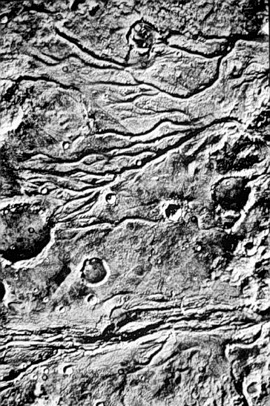
Some of the big surprises were infrequent but distinctive sinuous channels, whose morphology is much more similar to river channels that lava channels. One interpretation holds this morphology as evidence of sufficient water in the past, in lakes, groundwater or possibly oceans, to have initiated some sort of hydrologic cycle involving rain storms and runoff. Most water has since evaporated into space, although small quantities may remain frozen as underground ice. Nevertheless, significant water activity has recurred as evidenced by the types of dendritic channeling shown in these Viking Orbiter image mosaics:

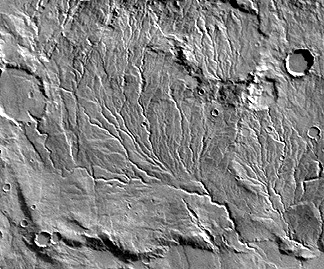
The region depicted in the top image covers the Juvenae Chasma and Vedra Vallis. These are runoff channels, a type confined to the ancient landscapes. Stream flow is the favored origin, largely by comparing them with terrestrial counterparts, but multiple lava flows are a possibility. Some channels seem to originate at craters, which could imply that subterranean sources released either water or lava, following impact offloading. The drainage pattern in the bottom image resembles terrestrial patterns found in soft sediments or wind deposits.
19-42: What is the argument that the type of channels shown above is not volcanic sinuous rilles or collapsed lava tubes? ANSWER
A second type of drainage we call outflow channelling. The channels typically are broad and deep, creating canyon-like depressions. This type of landform may have been associated with catastrophic scouring during abrupt flooding. A similar example on Earth is the Channeled Scablands of central Washington State in the U.S. that developed in just a few weeks from rapid emptying of a huge dammed lake after a natural breakup. Outflow features commonly occur next to chaotic terrain (top image, below; note the large outflow channel in the middle), in which surface units break into jumbled blocks and huge slabs, left behind after subsurface waters escape, leading to loss of support (a process called sapping). We consider a teardrop-shaped landform in Elysium Planitia (bottom image) a prime example of shaping by streamlining (analogous to aerodynamic sculpturing), in which water flowing from bottom to top has eroded plains material around the rim of a large crater and has terraced and perhaps redeposited debris towards the pointed end.
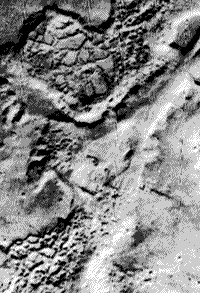
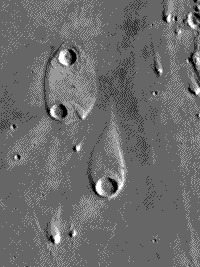
19-43: Present an argument as to why the teardrop landform was caused by water rather than wind. ANSWER
A recent paper has presented an alternative to water as the prime liquid medium responsible for the above channels and streamlike patterns. In this view, CO2 (carbon dioxide) is proposed to exist in liquid form and in flowing upon expulsion at the surface brings about the erosional features described as fluvial. A variant of this suggests that liquid water at the times in the past when Mars was warmer may have contained a significant amount of dissolved carbon dioxide ("soda water") that increased its ability to erode.
The martian surface is amazingly varied, with landforms of diverse genesis, some probably related to water action, as you have just seen, and others to tectonic forces, volcanism, and wind, being given descriptive names. Here are four examples:
The mishmash of intersecting linear features, called grooved terrain , in this case may be a complex surface of eroded ash deposits or possibly joint enlargement of a now buried remnant of a volcanic lava unit.
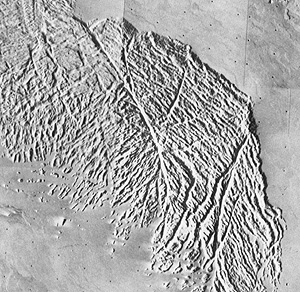
In the next image is an
example of polygonal terrain, which resembles, on a huge scale, fractures
found on lava lake surfaces or patterned ground, associated with ice wedging
in periglacial regions (areas adjacent to ice sheets).
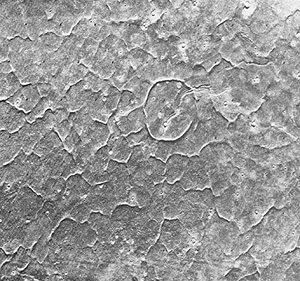
The last image dealing
with possible water-influenced ground shows fretted terrain, found usually
near cratered terrain, consisting of separated higher mesa-like units, bounded
by scarps and set within lower smooth plains. This terrain may represent incomplete
dissection of older landforms by water and/or wind.
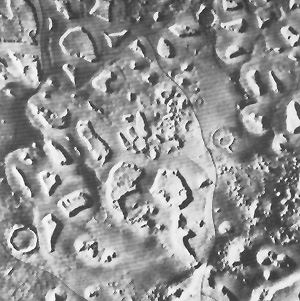
The next image portrays etched terrain which consists of shallow depressions likely developed by wind scouring and deflation of easily erodable unconsolidated surface materials.
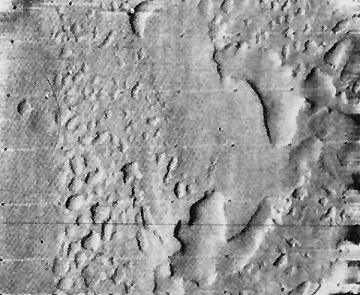
Other landform types given distinctive names (see the map near the top of page 19-11) include: furrowed terrain, knobby terrain, channeled terrain, and layered terrain. Examples of several of these are shown elsewhere in the Mars subsection.
19-44: From the above list, decide which name best fits the terrain shown in the image below; ignore the large craters. ANSWER

The importance of those landforms with fluvial signs is that they suggest a probability that water did (does?) exist in sufficient volume and concentration on Mars as an essential ingredient for the inception of organic molecules. Carbon, the other vital constituent, was certainly present as indicated by today's atmosphere. Whether these elements came from the interior or from meteoritic matter, during the accretion phase or later, is still uncertain. The absence of any viable organics in samples analyzed at the Viking sites does not disprove the possibility of biogenic forms in modern Mars. The sample may not have encountered organics there but they dwell elsewhere. Both sites were in younger terrains, so the nonoccurrence could mean that any earlier life or unorganized organic matter had perished by then.
Before (or after) reading through this subsection, you may wish to look over these four Web sites:(1) (2), (3), and (4).
The sensation in the scientific world during 1996 was the claim that a meteorite from Mars contained evidence of life. Scientists recovered twelve meteorites, mainly from the Antarctic, which they generally accept as coming from Mars, after impacts that hurled them into Earth-crossing orbits. These form a group known as the SNG meteorites (consisting of the Shergotty, Nakhlite, and Chassignite types). One, known as the Allan Hills meteorite (ALH84001), has several features interpreted as consistent with organic structures found in some ancient terrestrial rocks.
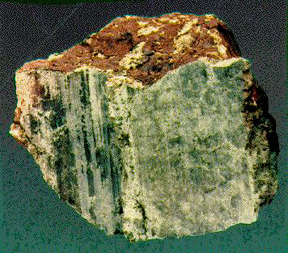
This fragmental rock contains dark materials, thought to be old martian crust, that date from 4.5 billion years ago. Golden-orange carbonate globules, dated at about 3.6 b.y., are considered evidence of a primitive ocean. Associated with the globules are small amounts of polycyclic aromatic hydrocarbons that, while not necessarily biogenic, are interpreted by some as indigenous to Mars rather than contamination after Earth-arrival. Fossil-like bodies consisting of the iron oxide magnetite and iron sulphides are present.
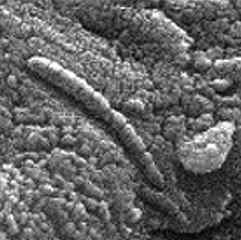
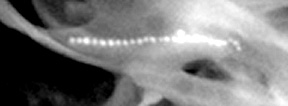
A second Antarctic meteorite, EETA79001, contains carbonate (suggesting martian sediments) and organic matter. This is anomalous in that both it and ALH89001 are volcanic rocks.
Needless to say, many skeptics have argued that this evidence is not persuasive; some similar features found in Earth rocks were inorganic. A recent report now claims that these tiny forms are indeed primitive bacteria but very similar to types still thriving on Earth; the implication is that this is just terrestrial contamination.
However, the possibility that they are genuine remains: if we certify life on Mars, the Earth would no longer retain its unique status as the living center of the Universe; although it is a huge leap from microscopic primitive organisms to the intelligence that then understands them. Suffice to comment that some scientists are touting these meteorite "life forms" as a pressing reason to formulate and accelerate a major space effort to return to Mars for more detailed exploration.
19-45: What would be the best proof of life on Mars? ANSWER
And, after a 20-year hiatus in Mars exploration, the quest for onsite information about our red neighbor has resumed. Several of these are described at JPL's Missions sites (Current comes up, check also Past and Future). First up was a launch in 1993, of the Mars Observer, a billion-dollar spacecraft, which, regrettably, failed enroute. The Mars Global Surveyor MGS) followed on November 7,1996, with its operation directed by JPL. The spacecraft arrived for orbital insertion on September 12, 1997. In December of 1996 the Pathfinder mission was underway, to land a roving vehicle capable of viewing the local terrain and making sophisticated measurements. An orbiting spacecraft, whose task is mainly climatic measurements launched in mid-December of 1998.
From an initial orbital altitude of 400 km (249 mi), the Global Surveyor used the aerobraking technique, which involved progressive slowing through air friction (drag) with the thin atmosphere, until, after six months, the spacecraft lowered to 110 km (68 mi). From there, using thrusters to maintain this altitude, a mapping mission began in late-March of 1998 to last a minimum of 687 Earth days. A second lowering was executed in 1999.
The Global Surveyor has a wide- and narrow-angle camera system (MOC or Mars Orbiting Camera), the Mars Orbiter Laser Altimeter, a Thermal Emission Spectrometer to measure atmospheric heat and surface composition, a Magnetometer/Electron Reflectometer, and two other instruments. Among the first surface images, taken from the higher altitude in early October of 1997, are these two examples of the many views from the mission. The top image (175 km; 108 miles) is of a section of Labyrinthus Noctus, a maze of interlocking grabens. The bottom image is 12 by 12 km; it shows a canyon wall in an unidentified area of Mars.
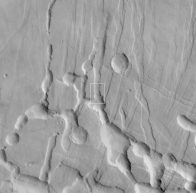
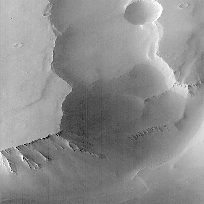
This next image is not a computer-generated perspective of the right image above, but was taken from MGS when its MOC was tilted 25° towards the horizon so that the view of the canyon walls is an actual scene with a 12 meter resolution, even though the target view is 1600 km (1000 miles) away.
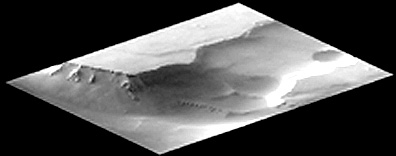
The Mars Orbiter Camera (MOC) can take pictures with resolutions of 3 m (9.8 ft). This resolution will improve slightly over time, as the orbital height lessens, because of the aerobraking effect. A very large number of these images can now be viewed online at the Malin Space Sciences System site. Several of the images shown below are credited to NASA/JPL/Malin Space Sciences Systems (referenced by MSSS).
The next view (MSSS), taken after the orbit lowered to the altitude chosen for the first major scientific measurements, shows details of the terrain surrounding an elongated volcanic caldera, 2 km in length in the Tempe-Marcotis Fossae region. Almost touching it is a round crater that may be impact in origin. The surface surrounding these two features is marked by small dunelike features probably built up by wind action
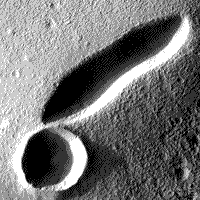
Layering of the bedrock of Mars (presumably either lake sediments or dust beds or volcanic flows) has been imaged at several martian locations. Here is an MOC view (MSSS) at 7 meters resolution of the wall of Candor Chasma in Valles Marineris that shows distinct layers.

19-46: What can you say about the layering seen along the left facing cliff in the right center of the image? ANSWER
Many Mars investigators, including Dr. Michael Malin, assert views such as above a unequivocal evidence for layering. Examine this view (MSSS)of another part of Candor Chasma:
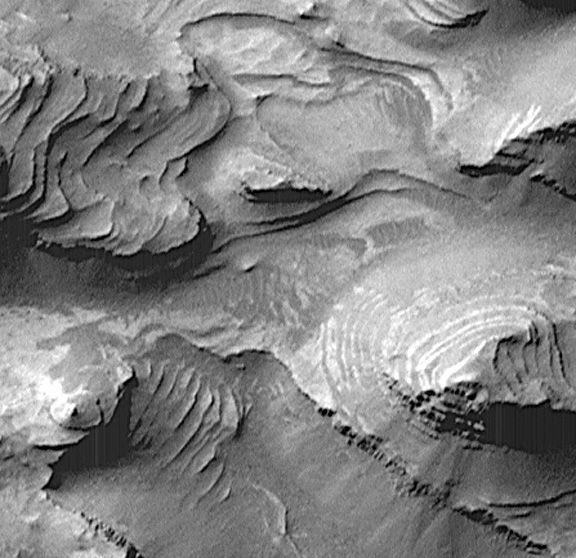
Note that the so-called layers are arranged stepwise in terrace or benchlike patterns in part of the image. Such offset "layering", if this it be, is sometimes found associated with mesas in the horizontal rocks of the Colorado Plateau. In the butte-like prominence at the center right of the image, the layers are well exposed along the steep sides.
Units that are almost certainly layers have been exposed at the West Arabia Terra Crater as seen in this image (MSSS). Here they appear inclined or dipping; but in an image from the crater center they look more horizontal, as expected if an impact crater hits on a sequence of non-inclined beds, with the dips then caused by the cratering action (on Earth craters [e.g., Meteor Crater in Arizona] in horizontal bedrock will show strongly inclined and even overturned layers outward towards the rim).
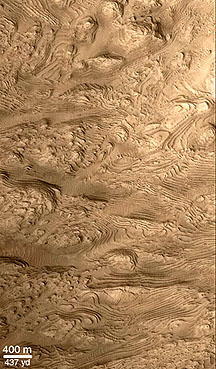
The MOC onboard the Mars Global Surveyor has been returning some provocative high resolution images that, after much interpretive debating, many geoscientists now believe offers supporting evidence of either water escape in the recent past or even indications of water still emerging. This MOC view below (5 m resolution) indicates channels coming from material in or below the edge of the southern ice cap. The stream outflow, if that is a valid identification, in each rill ends up with a small fan of deposits at its terminus - again, a feature consistent with fluid transport.
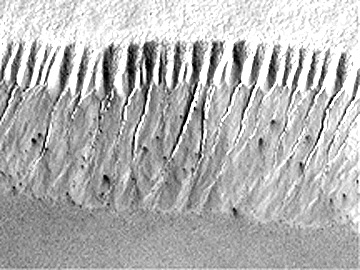
This Mars Global Surveyor image shows something unusual - what appears on the right to be a wedge of frozen ice cascading downslope. This has been interpreted to indicate that water moves at shallow subsurface depths and here extrudes at a canyon wall where is freezes (much like the ice sheets seen in roadcuts during winter). If so, this further supports the argument that the rills or gullies also seen in this image are water-generated.
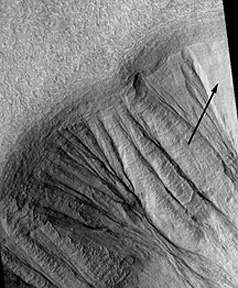
This pair of images offers solid proof that new small and local markings develop even today on Mars. A single black streak appears on the left (1998) image of part of a crater wall. On the right arrows point to new black streaks that appear between then and 2001. These are interpreted as related to water outflow.
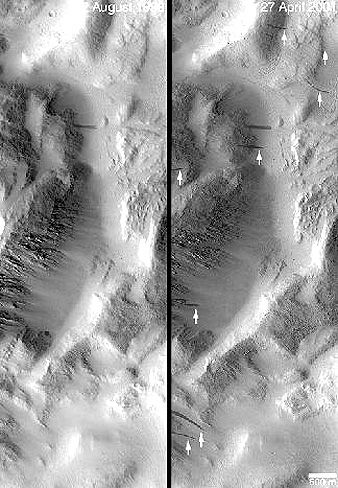
The next three images (NASA JPL and Malin Space Science Systems [MSSS]) demonstrate how planetary geologists go about interpreting and reasoning to conclusions using imagery returned from martian satellites and probes. The argument to be devised uses Martian Global Surveyor data to examine the region illustrated in this topographic map:
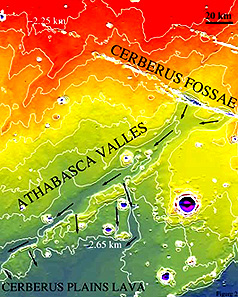
The Cerberus Fossa (channel) includes this 100 m wide, 10 m deep straight feature that, by comparison to similar areas on Mars, is almost certainly a tectonic graben, bounded by faults on either side expressed as steep walls. Emanating from the upper wall is what appears to be lava flows spread over both the flat land beyond the fault and into the graben floor.
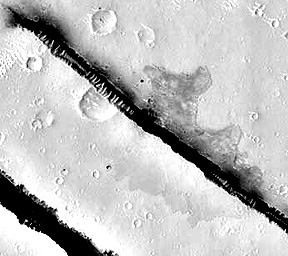
The Athabasca Valles extends southwest of the Fossa. It resembles a stream-cut valley similar to some on Earth. Within it is strong evidence of stream flow in the form of the streamlined, tear-drop shaped flatlands within it (see above on this page), such as shown here:
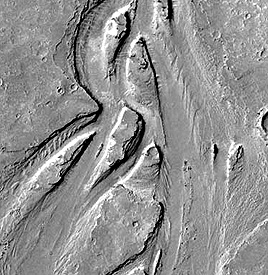
Water is presumed to have excaped from the Cerberus Fossa during, or at different times from, periods of volcanic activity. The amount of water needed to develop the valley is estimated to be about that found in Lake Erie today. Based on crater counts and other data, geologists believe that the principal valley-forming events may be as recent as 10 million years ago.
19-48: What causes the numerous indentations found in several of the dark layers? ANSWER
The Ma'adim Vallis (white arrow) is a 2.1 km (6900 ft) deep cut into the Southern Highlands that runs from a topographically lower area to the Gusev crater. H. Irwin III, G. Franz of the National Air and Space Museum (NASM) and others have published evidence that the low area was once filled with water in several lakes whose extent, if on Earth, would extend across Texas and New Mexico. They have reconstructed these lakes (not now existing) by coloring the topographic lows blue against a Mars image of the region:
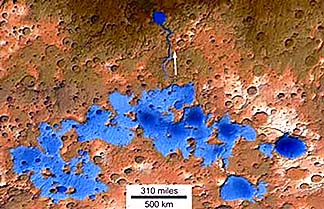
In their model, at some stage in Mars' past, the water from the central lake burst from its confines and rushed through the already forming valley, thus deepening it rapidly (analogous to the Scablands of the State of Washington; see above).
A new line of evidence for water and/or ice on Mars has come from MGS images of what is considered to be analogs to phreatomagmatic "rootless" volcanoes on Earth (especially in Iceland). Consider this image (MSSS) of a swarm of cones in the Cerberus Plains near the martian equator:
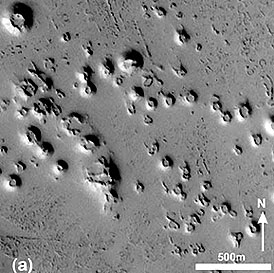
The origin of these miniature cones (typically, about 50 meters at their base) requires water to have been released at earlier times that becomes trapped near the surface (perhaps at depths of 3-5 meters). At the cold martian temperatures, this water is preserved as ice. Then, later eruption(s) of volcanic flows heat the water to steam, causing a pressure buildup that ejects material locally to build up the cones. The implication of the presence of these cones on what may be a young surface is that ice entrapment may occur within suitable martian terrains and could thus be available as a source of water during human exploration of this planet.
The Laser Altimeter (MOLA) on the Mars Global Surveyor yields maps and profiles that show martian relief. The next figure is a flat projection map of the entire martian subpolar surface produced from a large number of orbital lines with data taken at every 60 km (37 miles) yielding 27 million data points. Vertical resolution is 13 m (42 feet). Highest elevations are shown in white, with progressively lower elevations in brown, red, yellow, green, and blue (lowest).
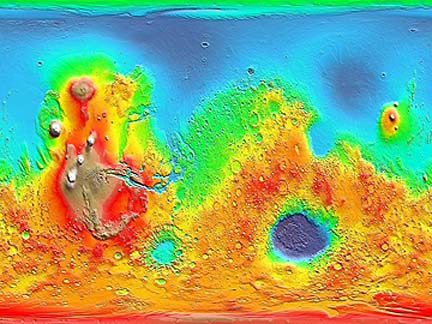
The southern hemisphere is, on average, 5 km (3 miles) higher than the younger northern hemisphere. The maximum relief on Mars ranges to 30 km (19 miles), about 1.5 times greater than that on Earth. The three white round areas are the Tharsis volcanoes and the offset white one is to the left. The brown rounded area above these is Alba Patera. Valles Marineris is obvious. The blue-green circular feature below is Argyre Planitia. The large elliptical blue region in the red southern hemisphere is a huge topographic depression about 2100 kilometers (1300 miles) wide and up to 9 km (6 miles) deep, with a rim that reaches 1.5 km (1 mile) in relief. This, the Hellas Basin, so far is the biggest impact crater known in the Solar System. To emphasize the size of this structure: If all material excavated from it were to be spread evenly over the 48 continental United States, a layer of debris some 3.5 km (2 miles) thick would accrue. Below is an enlargement of the map covering this structure.
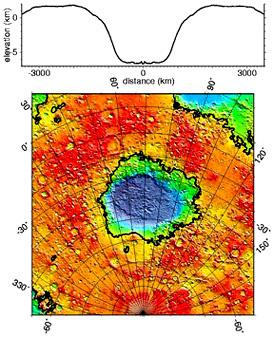
Probably the most dramatic
of these MOLA data plots presents an exaggerated profile across Olympus Mons
and Arsia Mons/Alba Patera.
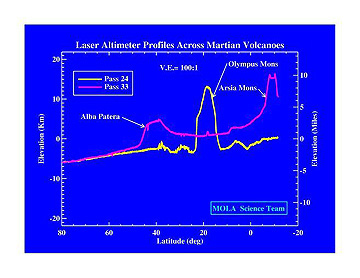
19-47: Compare the relief (difference in elevation) between Alba Patera and Olympus Mons. ANSWER
One of the most exciting and informative scenes taken by the Global Surveyor combines a color view of the North Pole Ice Cap with topographic data obtained from a series of Laser Altimeter passes to produce this three-dimensional view:
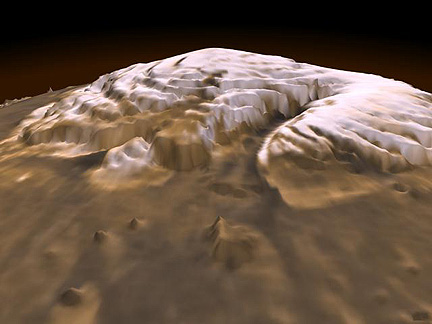
The size and amount of ice (which the spectrometer confirmed was largely water ice) was less than anticipated from pre-Surveyor observations. The cap is roughly 1,200 km (746 mi) across (crudely circular) and as much as 3 km (1.9 mi) thick. With an average thickness of 1 km (0.62 miles), the volume of ice is about 1.2 million cubic kilometers (288,000 cubic miles), roughly half that of the Greenland Ice Cap on Earth. The cap's general surface is quite smooth, but the ice cap is cut by large, deep (up to 1 km; 3,280 ft) steep-walled canyons and troughs, which may have come from cracks enlarged by wind and possibly meltwater. The amount of water located at the North Pole, and lesser quantities now at the South Pole, does not seem sufficient to have once made an ocean over parts of Mars. It instead may be the remnants of any seawater that could have existed in the Mars past. Any relationship of this surviving water to the river-like channels on Mars is still speculative. Water may be widespread even now but would be subsurface. Detecting that water is one of the objectives of future Mars missions.
The Thermal Emission Spectrometer
can identify some individual minerals and determine in a semi-quantitative way
their proportions in the surface rocks (believed to be primarily basalt and
andesites). The mineral Pyroxene (an iron-magnesium silicate) occurs in rocks
found in Syrtis Major. Note its variable distribution, with the largest amounts
present in the darker areas of this region.
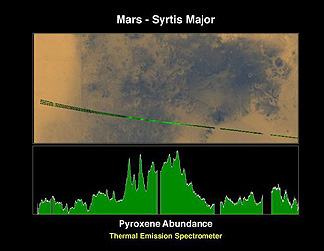
19-49: Account for the area that shows the highest pyroxene content; why? ANSWER
MGS sheds new light on the famous "face" on Mars first noted in a Viking image and seized upon by zealots favoring a lost civilization on the Red Planet as an artifact carved (like the Sphinx) into bedrock. The left view is the Viking image; the center (MGS) view shows the feature to have several mini-mountain peaks partly responsible for the fortuitous shadowing that highlights the face; the right view is a negative of the center view that recreates the shadowing.

A more recent image of the "face", taken by Mars Odyssey (see below) reveals an even more uncanny likeness to a face:
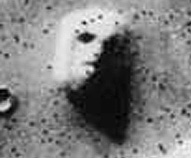
In this image, the rock promentory that looks like a nose even has a "nostril". Surrounding the "face" is a blanket of material that resembles hair. Judge for yourself what this feature might really be.
An April 1999 report by Mars Global Surveyor investigators has created a flurry of excitement about an aspect of the martian crust which may be a counterpart to the mobile segments of terrestrial crust that are involved in the concept of Plate Tectonics - a cornerstone in our understanding of the operation of the Earth's outer layers embodied in the idea of "continental drift". The Mars Global Surveyor magnetometer has picked out a series of magnetic stripes on Mars that systematically reverse their polarities. Thus:
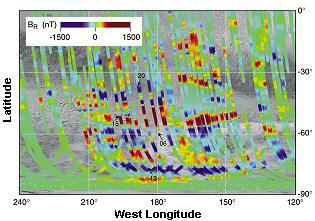
These martian strips are found mainly in the older terrains of the Southern Hemisphere. They trend at high angles to the polar axis. The implication is that this crust was formed by outpourings of lava from analogs to the terrestrial oceanic ridges that push the plates towards subduction zones (no such features have yet been recognized on Mars nor are there changes of mountains that result above these zones). This also suggests a much stronger magnetic field during early martian times; this would indicate a (partially) molten core. The full meaning of this new discovery is yet to be assessed.
Launched on December 4, 1996, JPL's Pathfinder landed on July 4, 1997, in the Ares Valle near the earlier Viking 1 site . This shorter transit time (seven months) resulted from a better alignment of Mars and Earth in their orbits The primary scientific purpose of Pathfinder was to release the small Sojourner Rover, guided from Earth through the lander's communication system. The Rover moved independently (after departing the lander down a ramp) up to 20 m away on its six, flexible, rocker wheels, to take pictures and bring its spectrometer against rock surfaces for analysis.
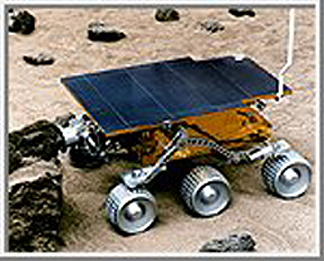
This microrover, which weighed 11.5 kg (25.4 lbs), measured the following: length = 630 mm (24.8 in), width = 480 mm (18.9 in), and height = 280 mm (11.0 in). Using power from a solar panel, Sojourner moved at a maximum speed of 40 mm/min (0.13 ft/min) during the martian day. Its front and back wheels moved independently to control its steering. The microrover used a stereo camera, mounted at its front, which imaged objects in its path. Each excursion was intermittent, because operators on Earth determined direction changes to reach target rocks and avoid obstacles. This took extended time periods because of the long distances radio and video signals traveled back and forth. When it encountered small rocks, the wheels raised up to glide over the obstruction.
The stereo camera system on the Pathfinder took images of the surface around the lander, obtaining black and white views and colored ones with color filters. Sojourner's camera also collected images (mainly rock close-ups). Next, we show a panoramic montage of most of the surrounding site, in which we identify (using friendly names that speak a personal touch) some of the rocks that it visited.
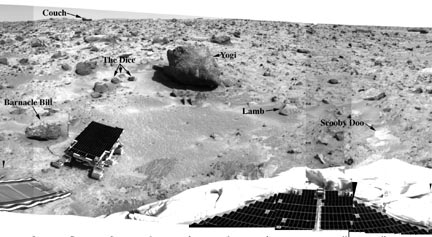
Many of the rocks are grayish on fresher surfaces. These surfaces appear weathered and pitted, and often are, at least partly, dust-covered. A typical large rock is Yogi (shown below), which appears to have a reddish dust blanket on one side and a sharp boundary with fresher rock (right side).
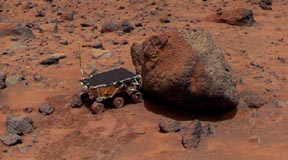
The primary instrument on the microrover is the alpha-proton-x-ray spectrometer (APXS). This instrument uses high speed alpha particles to bombard soil or rock surfaces. These particles generate a back scattering of alpha particles, alpha-proton particles, and x-rays, whose energies as determined at the detectors are indicative of a wide number of elements. It thus detects, quantitatively, elements such as those in rocks, i.e., Si, Al, Ca, Fe, Mg, K, Na, Ti, Mn, Cl, S, P, O, and C. It can report these elements in their elemental form or as oxides. The diagram below is a histogram of many of these elements from Barnacle Bill, Scooby Doo, Yogi, and some soil sites. Barnacle Bill's composition is close to that determined earlier at the Viking site but the other rocks and soils are different.
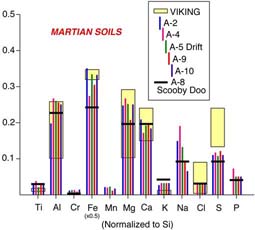
The next graph (top), is a plot of values of elemental ratios of Fe/Si and Ca/Si from the Pathfinder site, compared with certain Earth rocks. The Mars rocks are definitely not basalt. They plot close to but not within the compositional field of the terrestrial volcanic rocks known as Andesites. When we recalculate the elemental composition of the Pathfinder rocks into what petrologists term normative rock compositions, we see that the mineralogy is similar to andesites (bottom diagram).
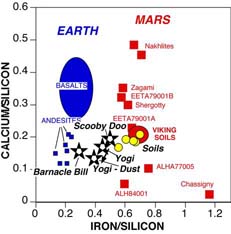
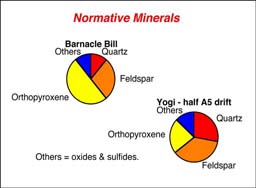
But the presence of normative quartz (leftover silica, after we assign all other SiO2 to the other minerals), technically makes this rock type a dacite. Andesites and dacites are the common volcanic rocks emitted from continental volcanoes, such as those along the Ring of Fire (e.g., the Pacific Coast Cascades). The presence of these rock types at this martian site, if typical of other sites, suggests that the Red Planet had melted and differentiated, so that at least part of its crust is andesitic. Paul Lowman (author of Section 12 of this Tutorial) had postulated more than a decade ago that an andesitic primordial crust probably developed early in Earth history and may be the norm for other inner planets.
19-50: Which rock should be darker: Barnacle Bill or Yogi? ANSWER
Landers have gathered compositional data at three widely-separated martian sites (the other two are the Vikings). In general, the sites are similar in their chemical makeup. This may simply mean that the martian crust is homogeneous, but even more likely is the explanation that martian wind circulation has scattered and homogenized compositional differences across the planet. The distribution of rocks and boulders at the Pathfinder site further supports earlier ideas that at one time in the Mars' past there was considerable water cover and resultant flow currents, causing a pattern sometimes observed on Earth as flood-related.
The last Pathfinder image we show below is a classic sunset picture, taken through the thin, dusty, martian atmosphere that produced a fan-shaped glow around the distant Sun.
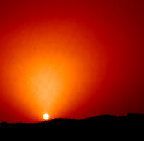
A series of spacecraft will be sent to Mars by 2005. The first, the Mars Climate Orbiter, was launched on December 11, 1998. but failed to reach its planned orbit. This was followed on January 3, 1999 by the Mars Polar Lander which apparently did not achieve a proper setdown, as no signal was ever received. There are a series of Mars Surveyors launched in the next five years culminating in Surveyor 2005 which will gather samples for a return to Earth. All of this is connected with the (tentative) U.S. decision to eventually send astronauts to Mars, after it has been thoroughly explored with these probes.
One successful probe is Mars Odyssey, launched on April 7, 2001. Because of the important discoveries it has been making, here is an artist's rendition of the spacecraft in orbit around the Red Planet.

Odyssey was inserted into orbit on October 20, 2001 and has now aerobraked to descend to about 300 km from the planet. One of its sensors, THEMIS, a thermal emission spectrometer, will survey the gross mineralogy of MARS. GRS, is a gamma ray spectrometer that will obtain compositional data covering 20 elements, in particular evidence of hydrogen that is tied with oxygen as water. Data collection began routinely in early 2002. In its fully operational mode, GRS is located at the end of the boom (see spacecraft picture above) which was deployed in June, 2002, Here is one of the first results: a visible image and an associated thermal map, made from THEMIS data:
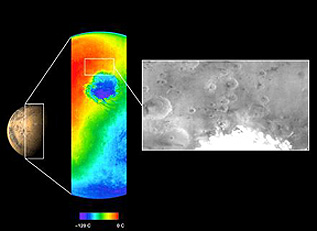
Bands 5, 7, and 8 on THEMIS were used to produce this color composite of Ganges Chasma in Valles Marineris. The scene is about 150 km (100 miles) on a side. Blues are correlated with basalts; the purples indicate a high olivine content.
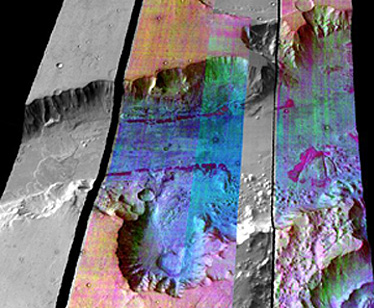
This next image from THEMIS shows a nighttime view of chaotic terrain on Mars. Note its similarity to nighttime thermal images shown in Section 9.
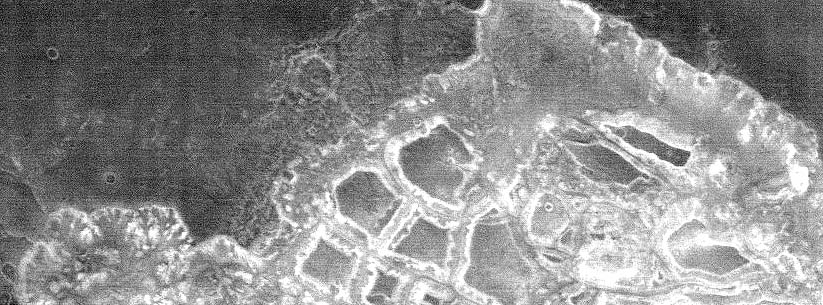
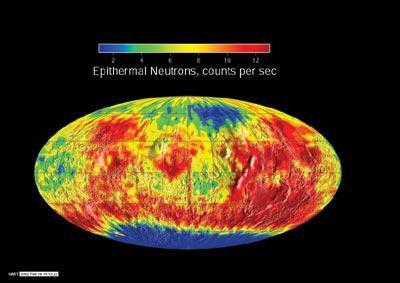
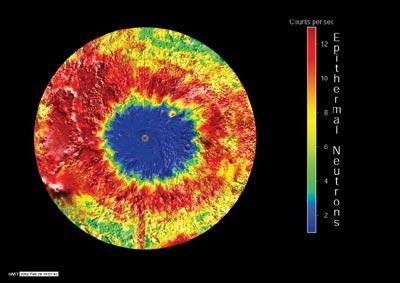
New maps, released in December 2002 indicate even more potential water (higher hydrogen content in purple) than earlier announced. This pair of global martian maps shows the hydrogen distribution first when the south polar cap was largely free of CO2 and later when the CO2 had sublimated of the north polar cap and to some extent resolidified at the south cap.
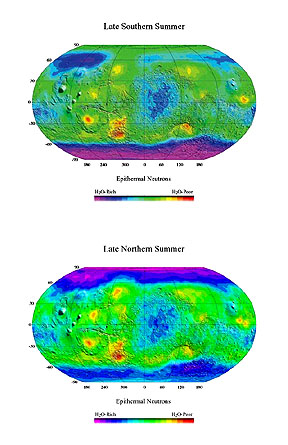
The current conclusion from these neutron data sets is that there is much more water at and just under the martian surface than had been anticipated from all previous hints from earlier missions. In the polar and high latitude parts of Mars, it appears that water ice is quite abundant in the top meter or so of the debris that seems to cover most of the planet. In places, water comprises more than 50% of that layer. The layer may be similar to permafrost in terrestrial rock and soil materials in Alaska, Siberia, and other high latitude land cover. Some of the martian layer can be considered as ice, with subordinate amounts of rock fragments. This may grade into a predominance of fragments cemented by subordinate water. Some ice seems to extend into the low latitudes of Mars. During each martian year a fraction of the water ice evaporates and is transported in the thin atmosphere to other locations. Estimates of the amount of water thus bound to the surface environment have ranged from the total present in Lake Superior to much higher.
This discovery needs verification and more specific new data. Needless to say, the likelihood of abundant water has galvanized that segment of the scientific community that promotes an ultimate manned mission to Mars. Presence of extractable water not only supplies drinking needs but processes exist to break down the water into hydrogen and oxygen gases which can be made part of a fuel system to power vehicles returning to Earth. Oxygen thus released could be used for breathing in any base established on Mars for continuing manned exploration. A number of missions to continue exploration have either been approved or are being carefully planned and considered. Among these are ESA's Mars Express (;aumch in 2003), two NASA Mars Explorer Rovers (2003), the Mars Reconnaissance Orbiter (launch in 2005; designed to improve water inventory), at least two NASA Mars Scouts (2007 and 2011), the joint French/NASA Netlander ((2007), NASA's Smart Lander (2009), and two NASA Smart Landers (second decade. Not all of these have received final approval. This next list includes possible candidates for the Scout program of small but well-equipped spacecraft:
Artemis: Three small landers and microrovers on the Martian surface, with two directed to the polar regions, to explore the surface and shallow subsurface for water, organic materials and climate;
Mars Environmental Observer: An orbiter to investigate the role of water, dust, ice and other materials within the Martian atmosphere to understand parts of the hydrologic cycle;
Mars Scout Radar: Orbiter mission that radar maps the surface geomorphology and very shallow subsurface -- down to about 10 to 16 feet (three to five meters) deep -- to detect buried water channels and other features;
Naiades: A suite of tiny landers that explore for subsurface liquid water using a novel low-frequency sounding method; and
CryoScout: Designed to use heated water jets to descend through Martian polar ice caps. Device could potentially probe to depths of tens to hundreds of meters, or yards, while measuring composition and searching for organic compounds.
NASA's home page on Solar System Missions has a section on Mars missions that describes most of the above.
Now, the final topic: the
Moons of Mars. It has been known since 1877 that Mars has two small satellites
- Phobos (mean diameter = 21 km; [13 miles]) and Deimos (17 km [10.6 miles]).
Mariner 9 captured the first detailed views of these tiny bodies. Their irregular
shapes are similar to asteroids that have been imaged by radar and their dark
surfaces are suggestive of the carbonaceous chondrite matter thought to comprise
these bodies; these insinuate that the martian satellites are captured strays
from the asteroidal belt that extends between Mars and Jupiter. Here is a view
of Phobos:
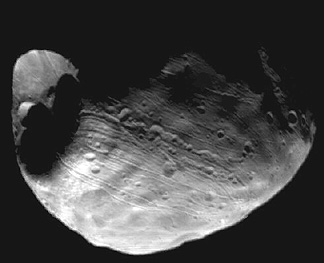
Small craters dot its surface but one large one, named Stickney, came close to disrupting it. This cratering is consistent with the likelihood of collisions with smaller objects during a period of residence in the asteroid belt. The grooves may relate to this crater.
Deimos has fewer craters and a smoother surface:
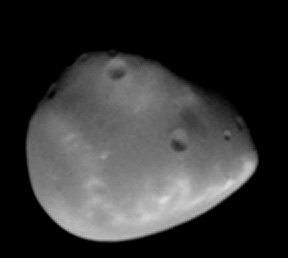
Mars, the outermost of the terrestrial planets, remains an exciting and diverse place to visit (perhaps by humans) in the foreseeable future. NASA, and much of the scientific world, continues to promote the idea of a Mars Manned mission, sometime after the year 2010, and after more unmanned probes visit the planet. The International Space Station, now under construction, and scheduled for completion in 2002, would be a favorable launch pad for Man's great adventure to the Red Planet.
19-51: Assuming enough fuel to get home, besides food what essential products would you need to bring with you if you go to Mars to explore for a week or so? ANSWER